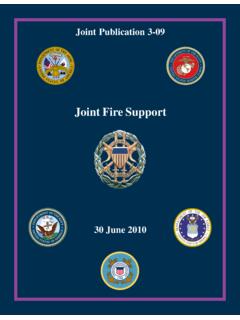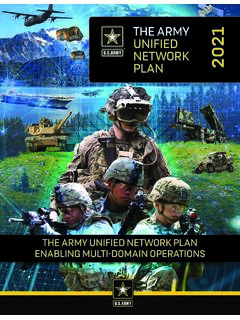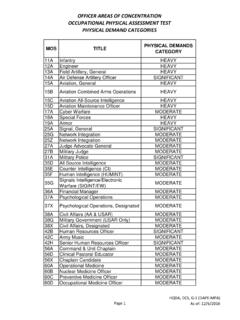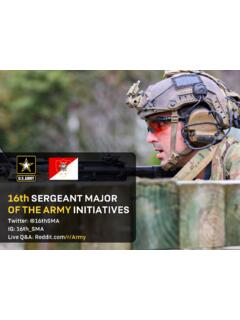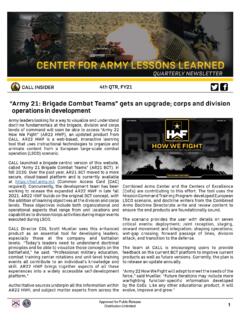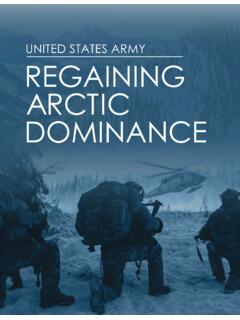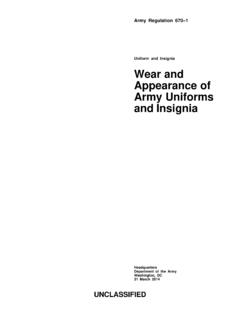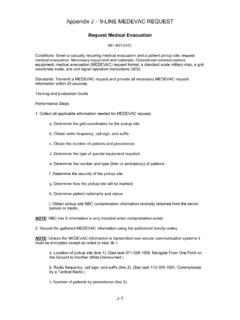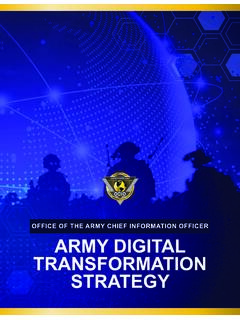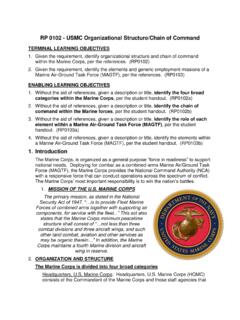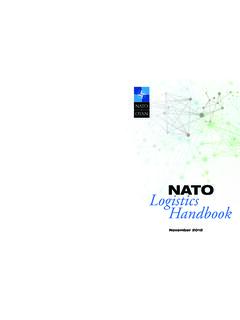Transcription of U.S. ARMY LOGISTICS
1 DEPUTY CHIEF OF STAFF, G-4 UNITED STATES ARMY LOGISTICS SEPT 2015G-4 LOGISTICS Strategic Planning Guidance G-4 LOGISTICS Strategic Planning Guidance 1 G-4 LOGISTICS Strategic Planning Guidance 2 EXECUTIVE SUMMARY As domestic and international events continue to unfold and various players emerge, security policy must adapt to ensure that our use of military power, economic power, diplomacy, political power, and power projection is responsive in meeting challenges. For the Army, in an era of force structure reductions and resource shortfalls, these challenges are addressed through the development of strategies that will guide our Army for next several decades.
2 These strategies encompass warfighting concepts which serve to identify capabilities and requirements that allow our Army to meet the obligations specified in the Defense Strategic Guidance, as well as Title 10. The mission of the United States Army is to win in the unforgiving crucible of ground combat. Army forces will prevent conflict, shape security environments, and win wars while operating as part of our Joint Force1 and working with multiple partners. The Army s contribution is providing a rotationally-oriented and surge ready force able to maneuver and employ capabilities to accomplish campaign objectives across the range of military operations using Regionally Aligned Forces (RAF) and mission tailored Forces.
3 In recognition of an increasingly complex world, the Army has undertaken several initiatives to ensure ready Army forces, now and in the future. In August 2014, TRADOC published a new Army Operating Concept (AOC) in alignment with Joint concepts. The Army is implementing a new Sustainable Readiness Model (SRM) to maintain the readiness of Forces within constrained resources. Our current and emerging sustainment plans, policies and resources must be perfectly nested within these efforts. The sustainment core capability structure of the Army Strategic Readiness Assessment (ASRA) will be the vehicle we use to constantly assess Army readiness and focus upon readiness improvement.
4 To provide a framework for LOGISTICS efforts, I have developed G-4 lines of effort: - LOE #1 - LOGISTICS Leader Development - LOE #2 - Strategic Readiness - LOE #3 - The Army Operating Concept / force 2025. We will build upon current capabilities to improve responsiveness, agility and precision for a range of contingencies. Our sustainment strategy must divest the Army of aging systems, sustain and modernize existing platforms by continuing equipment Reset, and evolve with development 1 Department of the Army (April 2014) 2014 Army Strategic Planning Guidance G-4 LOGISTICS Strategic Planning Guidance 3 of new capabilities through the investment in Science and Technology (S&T) and Research and Development (R&D) to exploit emerging technological breakthroughs.
5 Our modernization decisions must focus on maximizing long-term returns from investments in technologies that reduce demand on LOGISTICS , maximize common materiel solutions, and enhance the readiness of our Army. Improved efficiency and responsiveness will be realized through advances in integrated sustainment networks, development of distribution-management tools for tracking supplies and equipment, investment in LOGISTICS Enterprise Resource Planning (ERPs) with business intelligence (BI) capability to enable informed decisions, and autonomous transport technologies. We will reduce life cycle sustainment costs by using data-driven, knowledge-enabled actions; embedded prognostics; and decision support and analysis capabilities such as CBM+.
6 We will balance investment decisions within the guidelines of the Army Planning Guidance for the short-, mid- and long-term to mitigate risk within both the Operating and Generating force . This will require a holistic approach and a careful balance of investment and divestiture decisions. The geopolitical and evolving threat environment will continue to have significant implications for basing, readiness posture, and partner capabilities. The sustainment community has significant Title 10 responsibilities in support of the Joint force . The Army is at a crossroads as it emerges from over a decade of combat operations in Iraq and Afghanistan and we must be judicious as we transition from an Army of execution to an Army of preparation.
7 We will invest in capabilities and technologies which give our Soldiers decisive overmatch in any situation when they are placed in harm s way. Addressing future challenges will require an expeditionary, strategically adaptive and campaign-quality Army that prevents conflict, shapes the security environment and, when necessary, decisively wins conflicts to attain the strategic ends and policy goals that govern all military action. We must sustain the current force while balancing investments for the future. As an expeditionary force , the Army must sustain the ability to rapidly deploy a force of any size into a theater of operations regardless of its maturity level, and the Army must continue to strengthen our expeditionary capabilities.
8 Within a constrained resourcing environment, it is more important than ever that we work with the other Services to ensure capability and capacity to project a lethal Army force . Power projection platform investments are crucial as we assess the ability to deploy from fort to foxhole. Setting the theater, port opening, and sustaining the theater are critical missions for the land force and must be executed in any operational environment in order to support expeditionary maneuver. The associated implied and specified tasks for these missions are numerous and the Army G-4 will define required capabilities, identify risk, fight for appropriate resources, and determine mitigation strategies as necessary during every planning and resourcing venue.
9 G-4 LOGISTICS Strategic Planning Guidance 4 Table of Contents EXECUTIVE SUMMARY .. 2 Table of Contents .. 4 Strategic Environment .. 6 The Army Mission .. 7 Directed Army Planning Guidance and Priorities .. 8 Short-Term.. 8 Mid-Term.. 8 Long-Term.. 9 LOGISTICS Lines of Effort .. 9 Leader Development .. 10 Strategic Readiness .. 11 Army Operating Concept/ force 2025 .. 12 Looking 14 Conclusion .. 15 ANNEX A .. A-1 Sustainment Prioritization Guidance to HQDA .. A-1 General .. A-1 Purpose .. A-1 SS PEG Guidance .. A-1 Risks to Sustainment A-2 Key Sustainment Priorities (FY17-18/FY19-20) .. A-2 Sustaining PEG Imperatives .. A-3 Capability Prioritization.
10 A-4 G-4 Capability Standard Priorities .. A-4 Divestiture Recommendations .. A-5 Summary: Business Rules for MDEP Phases & Prioritization .. A-6 ANNEX B .. B-1 SS PEG Programming Guidance Program Objective Memorandum (POM) 18-22 .. B-1 Reference .. B-1 Purpose .. B-1 G-4 LOGISTICS Strategic Planning Guidance 5 Continue to Challenge Everything .. B-1 Fiscal Environment .. B-1 POM Focus .. B-1 Programming Guidance .. B-2 MDEP Managers must verify that Commands/ASCC/DRU Complete the Following .. B-3 Planning Facts .. B-5 Planning Assumptions .. B-5 ANNEX C Demand Reduction Strategy .. C-1 Purpose ..C-1 Introduction ..C-1 Background ..C-1 Areas Requiring Focus.
